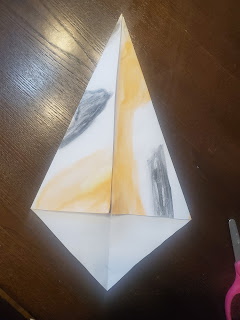Japan might be my favorite country unit study we've done yet! We found several awesome art and craft activities to try, made an erupting volcano, learned about the Pacific Ring of Fire, made teriyaki chicken, and lots more!
Basic Information
Japan is an island nation in eastern Asia. It's comprised of nearly 7,000 islands, of which only 421 are inhabited. The climate varies from sub arctic in the north to subtropical in the south.
Capital- Tokyo
Population- 126 million
Size- 145,937 square miles
Currency- yen
National Anthem- Kimi Ga Yo
National Animal- Japanese macaque
National Bird- Green pheasant
Flag-
Famous Places and Landmarks
Jigokudani Monkey Park- Jigokudani Monkey Park, also known as Snow Monkey Park, located on the island of Honshu, is famous for it's unique troop of Japanese macaques. Japanese macaques are unique in general, as they live further north than any other non human primate, but the troop of macaques that lives in the park are especially unique because they are the only troop known to bathe in the regions natural hot springs.
You can learn more about these fascinating monkeys here: The Story Behind Japan's Bathing Monkeys.
Mount Figi- Mount Figi is an active volcano about 60 miles north of Tokyo. It's a popular hiking destination.
Tokyo Skytree- The Tokyo Skytree is a broadcasting tower in Tokyo and it is the tallest tower in the world. It's observation deck is a popular tourist attraction.
You can take a short virtual tour here: The Heavenly View- Tokyo Skytree.
Fushimi Inari Taisha- Fushimi Inari Taisha is a Shinto shrine located in Kyoto, Japan. It's famous for it's series of gates and it's woodland trails.
You can learn more about Fushimi Inari Taisha with this short video: https://youtu.be/PQeHrn3q4Ic.
Recipes
For our Japanese meal we marinated some chicken breast strips in teriyaki sauce, stir fried them with some green bell peppers and onions, and ate it over white rice.
Some other Japanese recipes to try:
Volcano Activity
Japan is located at the junction of 4 tectonic plates, resulting in lots of earthquakes and volcanic activity. Japan is home to over 100 active volcanoes and Japan's volcanoes account for about 10% of all the volcanoes worldwide.
Learn a little bit about volcanoes with this sort video from National Geographic and then try building a volcano of your own!
For this activity you will need:
-an empty yogurt or other small plastic container
-a few tablespoons of baking soda
-a spoon
-a cup
-vinegar
-food coloring
-an area where you can dig in the dirt or sand
Go outside somewhere you can dig and build a mound in the dirt or sand. Build your mound around an empty yogurt or other small plastic container. Leave the very top of the container sticking out of the top of the mound.
Spoon a couple tablespoons of baking soda into the empty container. In your cup mix about a cup of vinegar and some red food coloring.
Carefully pour the cup of vinegar and food coloring into the container in your mound and enjoy watching it erupt!
Crafts
Paper Koi Fish Craft
In Japan koi represent good luck or good fortune. Look at some pictures of koi on Google Images and then try this paper koi fish craft!
For this activity you will need:
-white paper
-watercolors
-a paint brush
-scissors
-glue
-extra construction paper or coffee filters to make the fins
Start by cutting your white piece of paper into a square. Then paint orange and black spots onto your white square of paper with the watercolors. Set it aside to dry.
When your paper is dry, fold it like the pictures below:
Then cut like the picture below:
Open up your paper and glue the two uncut sections together.
Trim the top of the fishes face to make it rounded.
Then add eyes and fins with construction paper or coffee filters and glue.
Paper Fans
Folding hand fans originated in Japan sometime during the 6th or 7th century. They quickly became an important part of Japanese fashion and were often a symbol of status. Look at some pictures of traditional Japanese hand fans on Google Images and then try making a hand fan of your own.
For this activity you will need:
-a piece of white paper
-colored pencils
Turn your white piece of paper so that it is landscape oriented. Then draw a picture on it. Use the designs you saw on the pictures of traditional Japanese fans for inspiration. I drew cherry blossoms on mine. My daughter drew a bird with Mt. Figi in the background.
When you are finished fold your piece of paper back and forth like an accordion to make it into a fan.
You can learn more about the history of Japanese folding fans with this short video: The Story of Japanese Folding Fans.
Notan Art
Notan is an art style and design concept that originated in Japan. It focuses on the relationship and balance between light and dark features. An example most people would recognize is a ying yang:
Additional Resources
Here are some additional resources for learning about Japan:
-Japan from National Geographic Kids
-Japan Facts from Kids World Travel Guide
-Volcanos- What Are They? from National Parks of Japan
If you enjoyed this post, check out my other country unit studies:
Learning About the Countries of the World
Follow me on

























Comments
Post a Comment